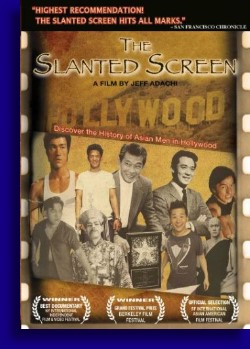

Reviewed by
Christopher Armstead


What had prompted me investigate this documentary from 2006 in the first place was the slight hubbub that arose from the film ‘21’ that in reality was based on a book about a group of predominately Asian students from MIT who took the Vegas Blackjack tables for boatload of cash counting cards, but in the Hollywood version all of the principle characters magically turned into white people for what I’m sure are economic reasons that some Studio executive has megabytes upon megabytes worth of Power Point presentations to support. Jeff Adachi, who is a part time documentary filmmaker to supplement his day job as a San Francisco Public Defender, has taken it upon himself to chronicle and investigate the plight of the Asian male in his very informative and engaging documentary, ‘The Slanted Screen’.
Adachi begins his film sliding some knowledge our way about the first American Movie Matinee Idol in the Japanese born Sessue Hayakawa, who even before Rudolph Valentino portrayed a dashing hero, lover of women, and a defender of right in numerous silent films. Mind you that this was American cinema no less which begs the question...How does an industry go from featuring an Asian man as a heroic sex symbol to not even allowing Asians to play Asian men in movies? Hayakawa’s popularity and success are even more astonishing when given the fact that the United States wasn’t that far removed from the fear of the ‘yellow peril’ in the late 18th and early 19th century, the U.S. government had passed laws greatly reducing the number of Chinese allowed to immigrate into the U.S. and often there were Klan style lynchings that various Asian groups were subjected to, though we should note the majority of this vitriol was aimed towards the Chinese. Given the brevity of the documentary at 67 minutes, Adachi through his various interviews and film clips can only touch on why this occurred during this time, though World War II and Pearl Harbor plays a major role during the middle of the century.



At the heart of the documentary are the various interviews with a number of notable male performers who range from the extremely bubbly, positive and hopeful Mad TV comedian Bobby Lee, from the from the slightly bitter Tzi Ma from ‘24’ to the crazy smooth and charismatic Cary Hiroyuki Tagawa who has played just a bad guy in just about everything I’ve seen him and is another actor, along with James Earl Jones and Sam Shepherd who mother used to talk about how ‘fine’ they were, making her youngest son very uncomfortable, and Adachi also interviews the Chinese American playwright Frank Chin who would just as soon kill them all. Through these interviews from these various men we learn, that is if we weren’t aware of it already, the incredible challenges that are faced when attempting to be an Asian actor, particularly a male actor as the film doesn’t really touch on the difficulties of Asian women, in the Hollywood studio system. It is apparent through watching these men speak, particularly the late Mako, that the thing that upset these gentlemen the most wasn’t the typecasting as a waiter or a delivery boy or even a bucktoothed buffoon, but the fact that white men were continually cast playing Asian characters, with David Carradine holding a very special place for these men in their Hall of Shame. The reasons for Carradine, who is still playing wise old Asians in TV commercials and such to this day, replacing Bruce Lee in ‘Kung Fu’… Bruce Lee for the love of all that’s holy... are probably the same reasons that that the producers of the film ‘21’ whited out the principle characters in their film as well. Even in the film ‘Enter the Dragon’, often considered landmark in changing the way Asian men are viewed in America, it is still a film rife with stereotypes as we observe the John Saxon character, a white man who finds a woman stays loyal to her and is essentially ‘in love’, the stereotype being that white men are honest, loyal and trustworthy. Compared to the Jim Kelly character, a Black man, who has at least a half dozen women and still can’t get enough with the stereotype being Black men are insatiable sex maniacs. Which leads us to the Bruce Lee character who doesn’t have a mate, just a fellow agent posing as a concubine which of course leads us to believe that Chinese men are a bunch completely neutered sexless ass kicking machines. Looking at the population of China that seems highly unlikely.
It’s interesting when comparing to plight of my own people, African American’s, to the struggles of Asian Americans in film. Black people have a couple of advantages being that we are a way more vocal minority, though this offers little protection it does raise awareness considerably. Second, and probably most importantly is that Blacks have always had their own separate film industry from the Oscar Micheaux’s films of the 30’s, to the blaxploitation era of the seventies (which the studios eventually took control of) to even the hood-type direct to video flicks of the present day. This is something that really hasn’t existed here for Asian community which severely limits the control that they have over their own images. Even in the independent Asian American film ‘Shanghai Kiss’ which quite amusingly chronicles an Asian American actor played by Ken Leung and his struggle with life in Hollywood and his own self awareness, the box cover is dominated by the decidedly Blonde Hayden Panetttiere with Leung, the films star, off in the background and absolutely no pictures of the insanely beautiful Kelly Hu to be seen. A shame and an indication that there’s still a long way to go.
Adachi’s documentary is a very entertaining and very a brisk chronicling of the history of the Asian male in Hollywood with its only drawback being that it is just far to brief which limits it’s ability to be more comprehensive on the subject. ‘The Slanted Screen’ tells a wonderful and informative story but I would be none too upset if Adachi were to start work on a ‘Part 2’.

